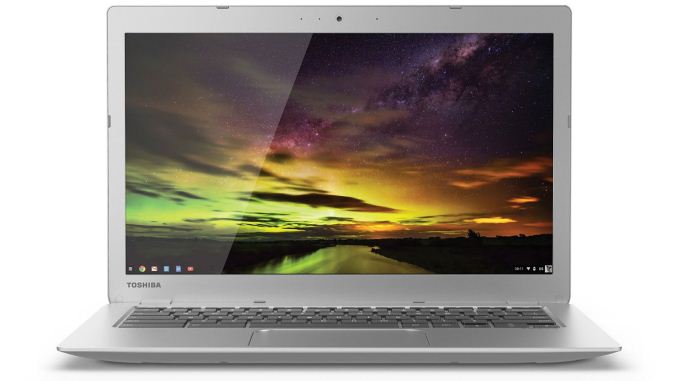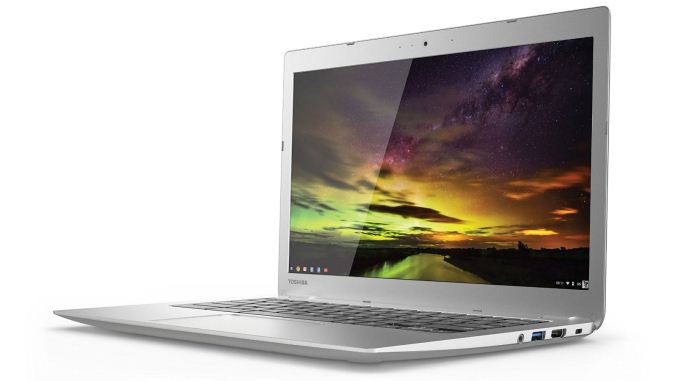Toshiba Chromebook 2: A Feast for the Eyes
by Jarred Walton on February 11, 2015 10:00 AM EST
Toshiba Chromebook 2 with 1080p IPS
We often complain about the effects of the race to the bottom – the race to the lowest possible price, regardless of what effect that has on overall quality. For more than a decade we’ve seen very little in the way improvements in display quality on laptops, with the primary change being the switch from CCFL backlighting to LEDs. In fact, it really wasn’t until the tablet market exploded that we started to see true improvements in laptop displays – or if you prefer, it was roughly around the time that Apple first released their MacBook Pro Retina.
Whatever you want to attribute the change to, there has been an increase in demand for good quality laptop displays, and that in turn has driven down the prices on such displays. Huzzah! We’re still a long way from putting TN panels behind us, but it’s now possible to find good displays in a laptop at price points well below $1000, which is great news. And it’s something that needs to continue to happen, as tablets are pretty much a guarantee that you’re going to get something better than a TN panel with a 250:1 contrast ratio; with tablet performance creeping ever closer to that of budget laptops, you can definitely make the argument for just getting a tablet with a keyboard...but that’s still a tablet with a keyboard rather than a laptop.
Chromebooks basically target that niche where there’s a desire for a true laptop experience, though obviously with some other qualifications. We've covered these before, but the biggest is that users need to be willing to leave behind the world of Windows and move to a new OS, but again with the proliferation of tablets, smartphones, Apple’s OS X devices, and a greater reliance on Internet and cloud-based services, people in general have become far less attached to their OS. Along with that, you need applications to perform everyday functions, with the Google Chrome App Store filling that role.
Chrome OS and the Chrome App Store also gives users the walled garden experience, ensuring that you won’t become a victim of the latest viruses and malware. It’s true that you can get a lot of that with iOS and Android, but Windows users at least have generally rejected that approach. And the Windows software developers are opposed to having a fully curated app store as well – look no further than Valve and their Steam OS initiative to see an example of this. For better or worse, Windows has a legacy of openness, and as the largest share of installed PCs it’s not something easily changed. At the same time, a lot of money ends up being poured into antivirus and antimalware tools, not to mention the support costs, so many are looking for an alternative. They’re saying, “Let Windows be Windows, but give me something easy to use and maintain.” For Google, Chrome OS is that something else.
Getting to the Toshiba Chromebook 2, let’s hit the spec sheet before we go any further. It’s important to note that there are actually three models of the Toshiba Chromebook 2 available, and when we say “Toshiba Chromebook 2” throughout this review we’re specifically referring to the model with the 1080p IPS display that we’re testing, also called the Toshiba Chromebook CB35-B3340. The Toshiba CB35-A3120 is actually the original Toshiba 13” Chromebook and sports a 1366x768 TN display with a Celeron 2955U, while the CB35-B3330 is the same as the model we’re reviewing but with a 1366x768 TN display and 2GB RAM.
| Toshiba Chromebook 2 CB35-B3340 Specifications | |
| Processor | Intel Celeron N2840 Dual-core 2.16-2.58GHz HD Graphics 4 EU GPU |
| Connectivity | 2x2 dual-band 802.11ac (Intel 7260NGW) Bluetooth 4.0 (Intel 7260NGW) |
| Memory | 4GB DDR3L |
| Storage | 16GB eMMC |
| Battery | 3-cell ~10.8V, 3860mAh, 44Wh |
| I/O | 1 x USB 3.0 1 x USB 2.0 HD webcam Dual array microphone HDMI Headphone/mic jack SD Card reader |
| Dimensions | 12.6" x 8.4" x 0.76" / 320 x 213 x 19.3 mm |
| Display | 13.3-inch IPS 1920x1080 |
| Weight | 2.95 lbs. / 1340g |
| Price | $330 MSRP, $329 Online |
Besides the inclusion of a great display – more on that in a moment – the remaining specs are pretty typical of Chromebooks. The processor of choice this time is Intel’s Celeron N2840, a dual-core Bay Trail chip running at 2.16-2.58GHz. The GPU portion of the chip is based on Intel’s HD Graphics architecture, the same architecture in Ivy Bridge and Haswell processors, but with only 4 EUs active. By comparison, the Celeron 2955U has 10 EUs, and they’re clocked higher as well, making the 2955U graphics potentially 2.5-3X faster. Whether or not that ends up being important is something we’ll discuss in our benchmark section.
Other features include two USB ports – one 2.0 and one 3.0 – an SD card reader, and a full size HDMI port. You also get 4GB of DDR3 memory (non-upgradeable) and 16GB of eMMC storage (plus 100GB of Google Drive storage for two years). The battery is a 3-cell 44Wh model rated for up to nine hours of battery life, which is good though not class leading. Compared to Windows laptops, some of the specs might seem a bit limited, but we’re talking about a $329 laptop with a good display, which is something you can’t currently find in the Windows laptop space. (Windows tablets however….)











66 Comments
View All Comments
gd22 - Wednesday, February 11, 2015 - link
Dinosaurs need to carry big hard drives, ultrabooks don't. I've had the Samsung 303c for 2 years plus, and never had a problem about the size of the drive. Maybe 15 to 20 times in those 2 years I've "increased" the size of the memory by using SD Cards.The video editing knock isn't fair to the Chromebook. If you need professional Adobe editing, then you need a MacBook and $600 Adobe software. For screencasting, and simple video like trimming the start and stop of a video, or a cut and paste, the Chromebook gets the job done, but it ain't great.
What Chromebook doesn't have is an easy way to use it as a developer. Installing Meteor, AngularJS, Ruby, basically can't be done, and have the Chromebook still be a Chromebook. For those with advanced skilz, it does have a nice SSH terminal for reaching your server.
Tin Weasel - Thursday, May 28, 2015 - link
I know I'm adding to a dead thread here, but I just set up a Dev environment on my chromebook using cloud9 online IDE, and it's working very well for me. You get a very functional code editor in a browser, and full terminal access to a VM on their end, set up for whatever you're doing. I haven't come across any major limitations yet, but I'm just getting into it. Check it out if you haven't already.jabber - Wednesday, February 11, 2015 - link
I love Chromebooks and think they are the way ahead for many. However, they have one big issue that stops me recommending them to the very people they are often aimed at.Printing.
It's still a mess. I hate printing but so many others live by the ability and Chromebooks still don't have a simple easy way to print. I have a Chromebook enabled printer and it's still hit and miss.
jabber - Wednesday, February 11, 2015 - link
As for my next Chromebook, I'd settle for a 11" 1600x900 IPS one.gd22 - Wednesday, February 11, 2015 - link
Yes. I also pro Chromebooks, but agree that printing experience is still a mess.aryonoco - Wednesday, February 11, 2015 - link
Great review Jarred, thanks for taking the time to review this machine.Just one thing I would like to add regarding your mention of the "walled garden" experience of Chromebooks. While on the face of it true, I think it's important to point out a huge caveat: Chromebooks have an official way to be rooted, it's easy to do that, requires no hacking or jailbreaking, and doesn't void the warranty. Once rooted, obviously the walled garden falls and you are in full control and can run anything you want, including an alternate Linux distro. As a bonus: you can even restore it back to a non-rooted "secure" state with no effort.
Plenty of people, power users in general, like to have full control of the machines that they "own". This is why a lot of us are hugely dismayed by Apple's walled garden approach and their quest against jailbreaking, or by many Android manufacturers who make it very difficult to root devices. Chromebooks offer the best of both worlds: a walled garden for the average user to keep them protected from the nasties, and the ability to fully own the system for those who demand such freedom.
derder1 - Wednesday, February 11, 2015 - link
About time, Anandtech! I've been waiting a review for since like Nov/Dec 2014! By the way what is RGB % that this display show?AnnonymousCoward - Thursday, February 12, 2015 - link
"sRGB" - about 72% I think.JarredWalton - Thursday, February 12, 2015 - link
Yeah, it's pretty close to full sRGB gamut, though I'm not sure how to get gamut in this case. (Normally, I get gamut from Windows laptops using the ICM file, but there's no way I know of to create an ICM for a Chromebook. I'm sure there's some way to still get gamut somewhere in CalMAN, but I admit that software is not my forte.)AgeOfPanic - Thursday, February 12, 2015 - link
I recently bought an Asus C200 chromebook. While it has some redeeming features, namely build quality and especially battery life, it is too slow in daily use. I understand that for the money you should expect some issues, but I find myself waiting on everything. Page loading, open Chrome apps and everything. It has a 2830 processor compared to the 2840 in this one, but then again the Toshiba got a higher resolution screen.I would be very hesistant to buy another Chromebook with such a slow processor. Chromebooks themselves are awesome though.